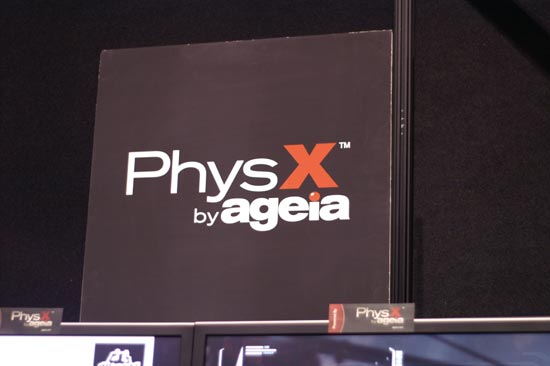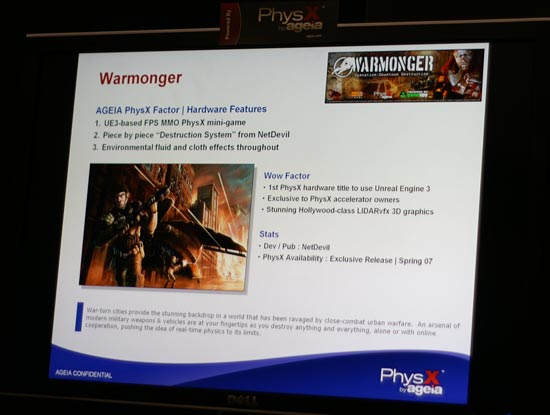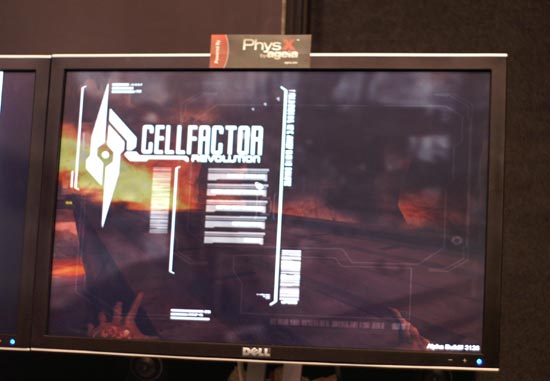CES 2007 Part I: Convergence Happened and the Most Impressive Demo of CES
by Anand Lal Shimpi on January 11, 2007 6:53 PM EST- Posted in
- Displays
Ageia has big plans for PhysX in '07
We met with Ageia at the show to go over plans for its PhysX accelerator and if there’s a future for the technology given the rocky start.

Ageia had no issues admitting that the PhysX launch wasn’t very good, so it is committed to fixing problems and doing whatever it can do correct the negative image of the first physics accelerator in 2007.

According to Ageia, 2007 will be a year of really ramping up the quality and quantity of games that implement PhysX support. Ageia hopes to achieve better overall quality through three major steps that are currently being implemented:
1) All PhysX titles that are released must go through some sort of an approval process before they can ship. This gives Ageia some input into the game development process and will hopefully mean that Ageia can pull support if a game doesn’t meet its standards. On the flip side, it also means that if mediocre PhysX implementations make it into games that Ageia will no longer be able to simply blame the developer; in the future, Ageia will be just as responsible as the developer.
2) Performance of a game with PhysX enabled must not be lower than with it disabled - you should no longer have the problem of better physics but lower performance. This is a big step forward for Ageia, as it is difficult to justify spending money on getting better physics if you end up reducing overall game performance as a trade off.
3) PhysX enabled titles must offer some sort of significant improvement with hardware acceleration enabled. Once again this is a sort of certification or stamp of approval by Ageia that the use of PhysX hardware will actually do more for your gameplay than make a nice tech demo.

Ageia remained fairly vague in how strictly it plans to enforce these requirements, but now it must share the responsibility if PhysX continues to be a failure by the end of 2007. According to Ageia, there will be three AAA game titles released before the end of 2007 that will make substantial use of its PhysX card, above and beyond anything that has been done to date.
Keep in mind that the PhysX core is still built on a 130nm process, so there’s room to reduce cost considerably. Ageia views the current PhysX implementation as a high end offering and plans on introducing lower cost variants to target other markets.
We left the Ageia meeting with a fairly strong statement from the company; by the end of 2007 Ageia expects the question of whether or not a PhysX card does anything to go away completely thanks to much better implementations in games and much better title availability.










18 Comments
View All Comments
artifex - Monday, January 15, 2007 - link
I'm getting offers in the ads from companies who claim to offer "free" stuff provided you join a lot of trial offers and buy a bunch of stuff and sucker your friends into joining, also.Does Anandtech approve of these ads? Don't say you have no control over them, because you do. You can complain to your provider, IndustryBrains, or switch if they continue to show these things.
The suckier the ads are, the less credibility you have among people who see them, and the more likely everyone will use adblockers, which will kill your revenue.
artifex - Monday, January 15, 2007 - link
You guys must be too young to remember G-Force, the anime. :)When Nvidia announced their first GeForce product, I thought they might get sued, themselves. But of course, g-force is a term that predates either.
Houdani - Friday, January 12, 2007 - link
<--- that's me being grumpy about Toshiba & Canon not displaying the SED TVs at CES'07 due to legal wranglings with Nano-Proprietary. This, of course, is only pushing out their availability that much farther, further closing the window on this tech. Hrmph!semo - Friday, January 12, 2007 - link
why is that such an issue? what is performance? some numbers you couldn't care less when playing assuming the fps stay above a certain number. you expect performance to drop when enabling other eye candy, but when it comes to realism everyone seems to complain.this makes me think, are ppl buying better video cards for the increased "performance" or for the more immersive experience.
Houdani - Friday, January 12, 2007 - link
Physics doesn't necessarily have to mean that more polygons are pushed to the screen (such as when things go boom). When this happens, then it taxes the video card more and has a subsequent impact on performance. I think this relationship is understood and accepted.However, if the physics don't add more polygons but instead cause objects to interact more realistically then we're at the spot where we don't want overall performance to slow down. This is where Ageia needs to flex their strength and not disappoint their audience.
In *software* we already have the ability to have great physics, but at a loss to performance. For Ageia to excel, they necessarily have to remove that hindrance and give us the physics without the performance hit -- otherwise they've provided us with little or no benefit, really.
semo - Friday, January 12, 2007 - link
that makes sense. how much of a performance hit are talking here anyway. and how much of the physics calculations are outsourced to the ppu (and are there any big overheads as a result)LoneWolf15 - Friday, January 12, 2007 - link
It would be, if you can make sure this product is extremely difficult to damage.
I've seen way too many students that don't care how they treat something a school gives them --after all, it's (in their minds) not like they bought and paid for it with their own money (the concept that their parents' taxes did is irrelevant in their minds in those cases).
I agree that the concept is brilliant on paper, and it should be perfect for higher education. In the K-12 evnironment though, unless there's a way of accountability that works without making parents upset, or a way of making them durable enough that this is not an issue, this could be an idea that falls one tiny step short of a great finish.
bokep - Friday, January 12, 2007 - link
I've been following OLEDs since I first learned about it over half a decade ago. Nice to see it working that well and should be coming out within the next few years.CSMR - Thursday, January 11, 2007 - link
Great reviews, thanks for keeping the world updated!archcommus - Thursday, January 11, 2007 - link
...let's be serious here, LCD is surely getting the job done just fine.